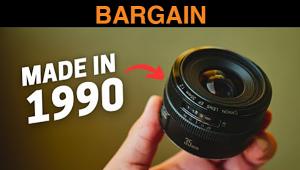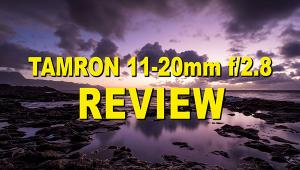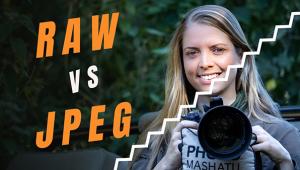Tamron’s SP AF180mm F/3.5 Di LD (IF) 1:1 Macro; A Macro Tele Lens For 35mm, APS-C, And Digital SLRs With Full-Frame Sensors
This fairly large (6.5" long, 3.3" in diameter), reasonably lightweight (32.5 oz, including removable tripod collar) macro tele covers the 24x36mm format in film or digital as well as the smaller APS-C digital format. The Di (Digitally Integrated) designation indicates that it's "optically designed for digital SLR cameras." To translate the remainder of Tamron's alphabet soup, LD denotes that the lens incorporates two Low Dispersion glass elements aimed at correcting chromatic aberration that's usually more pronounced at close-focusing distances, IF stands for Internal Focusing, and SP means this 180mm macro is part of Tamron's Super Performance Series, claimed to provide superior imaging. The lens is available in Nikon AF, Canon EOS, Pentax K-AF, and Konica Minolta mounts, but only the first two incorporate an AF/MF one-touch switchover mechanism built into the focusing ring.
 |
|
 |
|
 |
|
|
Why A 180mm Macro?
Why would anyone opt for a 180mm (270mm equivalent in APS-C) macro lens instead of one in the 50-60mm or even the 90mm range? The two-word answer is "working distance," that is, the distance from the front of the lens to the subject. At life-size (1:1) magnification, the working distance of Tamron's 180mm macro is 25cm or about 10" (without hood), but it's only 9cm (21/2") with a 90mm macro and 5cm (2") with a 50mm macro. This difference can be critical when it comes to spooking skittish subjects like insects or birds, and the shorter the working distance, the more difficult it becomes to illuminate close-up subjects by aiming lights in from the sides in between the lens and what you're shooting. Being able to capture dramatic close-ups without having to get right up to the subject can also be very handy when shooting everything from flowering trees to small critters like squirrels and opossums. In short, a 180mm macro offers the advantages of a long telephoto lens and a macro lens rolled into one.
Can't you achieve the same thing with a macro zoom lens? If it provides close-focusing capability at the tele end, it might be OK for occasional macro work, but there are two main reasons why serious macro shooters are far better off with a true single focal length macro tele lens:
1. Unlike macro zooms, all true macro lenses are optically optimized for close-up magnification ratios (typically about 1:10) and therefore provide noticeably better correction (visible as sharpness and contrast) at close-shooting distances than general-purpose lenses, which are designed to deliver optimum performance at infinity.
2. When using a macro zoom for close-ups, you often have to shoot wide-open at effective apertures in the f/5.6-f/8 range at the tele end, and then stop down another 1-2 stops if critical sharpness is required. With a true macro tele, you can achieve critical sharpness even wide-open or by stopping down half a stop, and the only reason to stop down further is to increase depth of field.
 |
||
 |
 |
|
 |
||
|
||
Aside from its moderately large size, the only real downside to a 180mm macro telephoto is cost--even the independently-made Tamron 180mm f/3.5 Macro, which is far less expensive than, say, the Canon 180mm Macro (it's just under $1200 street) carries a street price of $699.
Hands-On Operation
For a physically long lens the Tamron 180mm f/3.5 Macro balances surprisingly well on an enthusiast digital SLR like the Canon EOS 20D, or the larger, heavier EOS 5D. For handheld shooting you can shave a few ounces off its weight by removing its tripod platform, which has a hinged collar and a clever twist-and-pull locking knob. The grippably textured 21/4"-wide focusing collar pulls back to Manual-Focus (MF) position and pushes forward to AF position on Nikon- and Canon-mount models, a very convenient system that lets you focus manually in an instant if you need to. And you will need to fairly frequently when focusing on subjects in the macro range, because no AF system can decide which part of your subject should be in critically sharp focus but you! Fortunately, manual-focus action is very smooth and well damped, and autofocus is smooth, predictable, and reasonably quiet.
What, No AF Limiter?
One item you won't find on the Tamron 180mm f/3.5 Macro is a focus-limiter control that you can set to limit the autofocus range to near (typically 3 ft or under) or far distances. As a result, in AF mode, when you try to focus on a distant subject after shooting a close-up subject, the lens will first move to minimum distance before moving out and locking in on the distant subject--vice versa when shooting a close-up subject after a distant one. This adds a couple of seconds to the AF process--the lens never hunts back and forth or stumbles, it just takes its time. If this bothers you, it's a simple matter to pull the focusing collar back to MF position (which reveals a blue warning ring in front of the focusing collar), set a near or far distance manually, than push the collar forward to AF position before viewing and autofocusing on the next subject. Is a focusing limiter a better solution? Frankly, I think it's a tossup, because you have to remember to set it and unlock it, but it's a personal decision.
- Log in or register to post comments

















































